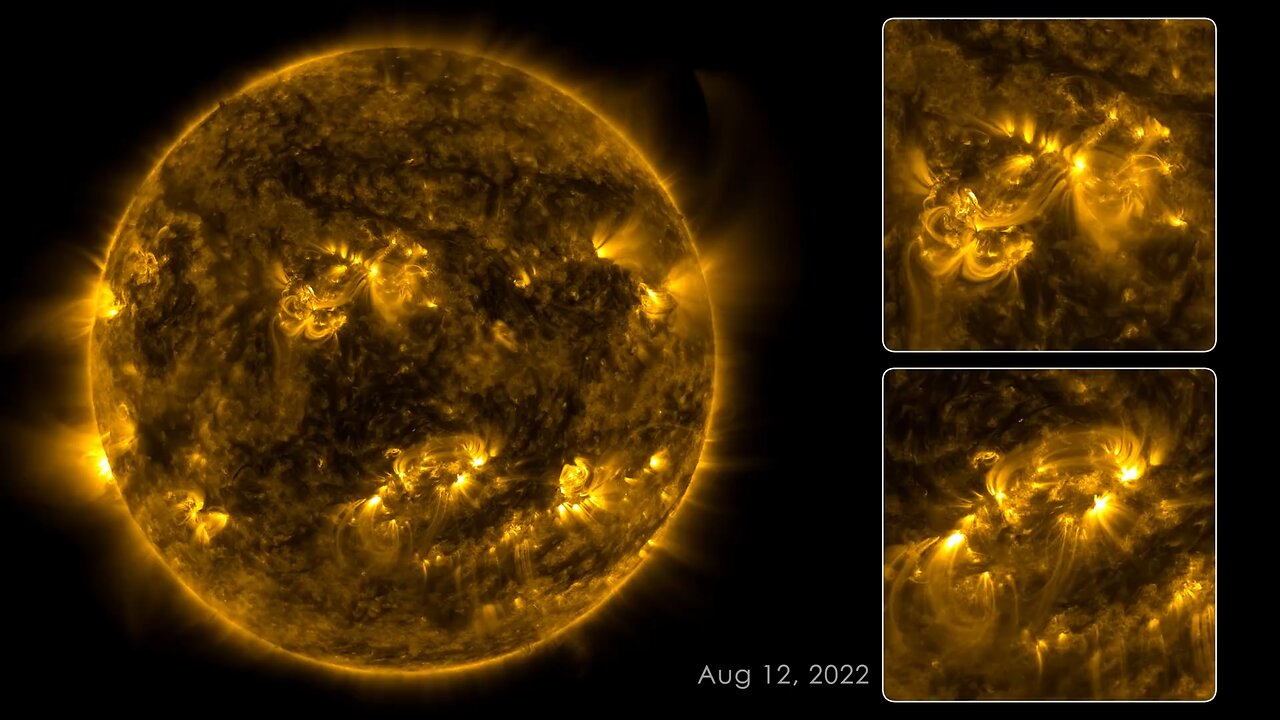Premium Only Content

133 Days on the Sun - Solar Activity Time Lapse
On the left side of the frame, the Sun presents itself as a luminous circle with golden-yellow hues, adorned with wisps extending from its surface. Bright regions intermingle with darker patches, vividly capturing the Sun's rotation, which takes 12 minutes for a full cycle in this time-lapse sequence. Dynamic bright regions shift and flare like small fires, forming wispy loops that gracefully shape-shift and reach into space above the solar surface. On the right side, two white-outlined squares offer close-up enlargements of intriguing regions on the Sun.
Dive into an extraordinary journey through 133 days of mesmerizing solar activity, captured by NASA’s Solar Dynamics Observatory (SDO) from August 12 to December 22, 2022. Orbiting the Earth in space, SDO has provided a steady stream of 4K x 4K resolution imagery of our Sun for nearly 13 years, unveiling unparalleled insights into the workings of our closest star and its influence on the solar system.
With an array of instruments, SDO captures the Sun's essence, snapping an image every 0.75 seconds. The Atmospheric Imaging Assembly (AIA) instrument adds depth, capturing images at 10 different wavelengths of light every 12 seconds. This breathtaking 133-day time lapse focuses on the extreme-ultraviolet wavelength of 17.1 nanometers, revealing the Sun's outermost atmospheric layer: the corona.
This captivating movie, comprised of images taken just 108 seconds apart, condenses over four months of solar observations into a mesmerizing 59-minute spectacle. Watch as vibrant active regions traverse the Sun's surface, gracefully rotating, while magnetic fields form dynamic loops above, trapping sizzling plasma.
The solar ballet unfolds against a backdrop of space, yet there are moments when Earth or the Moon eclipse SDO, causing intriguing dark frames. Despite these occasional absences, SDO continuously transmits 1.4 terabytes of invaluable solar data daily, helping us decode the Sun's mysteries.
The music, a harmonious blend from Lars Leonhard's “Geometric Shapes” album, accompanies this visual symphony. Credit goes to NASA's Goddard Space Flight Center, with Scott Wiessinger (PAO) as Lead Producer, Tom Bridgman (SVS) as Lead Visualizer, and Scott Wiessinger (PAO) as Editor.
-
 LIVE
LIVE
Film Threat
3 hours agoLIVE FROM SAN DIEGO COMIC-CON! (Saturday) | Film Threat Live
260 watching -
 31:40
31:40
Tactical Advisor
1 hour agoEveryone Talks About This AR15 Being The Best? | Vault Room Live Stream 034
44K3 -
 1:08:53
1:08:53
Michael Franzese
15 hours agoHollywood Deaths & Political Secrets: A Nation at a Crossroads?
140K84 -
 9:27
9:27
MattMorseTV
23 hours ago $13.48 earnedHe just lost EVERYTHING.
48.1K62 -
 1:40:30
1:40:30
I_Came_With_Fire_Podcast
14 hours agoPrivate Military Contractors Are TRAFFICKING KIDS Around The United States
29.5K19 -
 LIVE
LIVE
JdaDelete
15 hours ago $2.64 earnedFinal Fantasy VII Rebirth | Jdub's Journey Part 8 - Corel Prison
182 watching -
 2:39:09
2:39:09
LFA TV
20 hours agoTHE ARK ENCOUNTER LIVE EVENT! 7.26.25 9AM EST-12PM EST
207K26 -
 3:20:34
3:20:34
Sgt Wilky Plays
5 hours agoTherapeutics with Dr Kong
21.1K -
 1:10:23
1:10:23
Man in America
1 day agoAre MK-Ultra Parasites Rewiring Your Brain? | Detoxing, Peptides & Parasite Warfare w/ Diane Kazer
49.7K61 -
 18:12:15
18:12:15
TheSchleppy
1 day ago $1.23 earned✨TheSchleppy✨24HR 2 YRS ON RUMBLE STREAM! RIGHT INTO RUMBLE HALO EVENT!
21.4K5